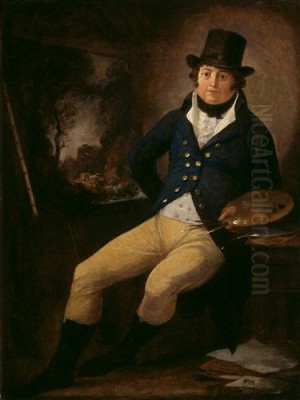
Julius Caesar Ibbetson stands as a significant figure in British art history, an accomplished landscape and watercolour painter active during the late 18th and early 19th centuries. His life, spanning from 1759 to 1817, was marked by extensive travel, personal challenges, and a dedicated pursuit of capturing the rustic beauty of the British countryside and the wider world. Renowned for his depictions of rural scenes, populated with animals and figures, Ibbetson earned the moniker "the Berchem of England," aligning him with the Dutch Italianate master Nicolaes Pieterszoon Berchem, yet he forged a style distinctly his own, rooted in the landscapes and life of his time.
Early Life and Formative Years
Julius Caesar Ibbetson's entry into the world was unconventional. Born on December 29, 1759, his birthplace is noted as possibly Farnley in Yorkshire, or perhaps more specifically Farnley Moor Top, near Leeds. A poignant family story suggests his name, Julius Caesar, derived from his birth via Caesarean section, a procedure necessitated by the tragic death of his mother, Rebecca Ibbetson, shortly before or during his birth. This dramatic beginning perhaps foreshadowed a life less ordinary. Following his mother's passing, his father, Richard Ibbetson, reportedly relocated, with some accounts mentioning a move to France and connections to a Moravian community, though details remain somewhat unclear.
Ibbetson's youth included a period of Puritan education. At the age of seventeen, he was apprenticed to a Captain Helder, embarking on a path connected to shipping. While this experience was reportedly not driven by a deep passion for maritime life, the exposure to ships, ports, and coastal environments undoubtedly provided valuable visual material that would later surface in his artistic endeavours. Seeking a different future, the young Ibbetson eventually made his way to London, the burgeoning centre of the British art world.
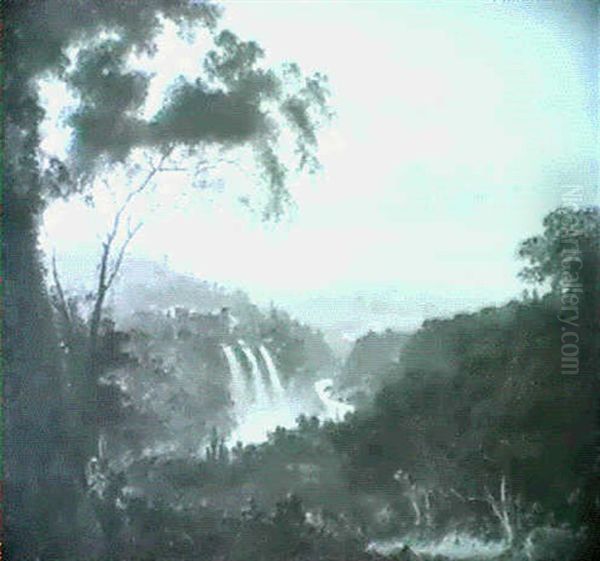
In London, Ibbetson sought formal training to hone his innate artistic talents. He became a pupil of the painter John Fletcher, learning the foundational techniques of the craft. His early professional work involved the practical application of art in the realm of theatre. Beginning around 1775, Ibbetson found employment designing and painting scenery for various theatre troupes, an occupation that demanded versatility and an understanding of dramatic effect and perspective, skills that would serve him well in his later landscape painting.
Emergence as an Artist
Ibbetson's transition from scenery painter to recognized easel painter gained momentum in the 1780s. A significant milestone occurred in 1785 when he first exhibited his work at the prestigious Royal Academy of Arts in London. This marked his entry into the established art scene, placing his work before a wider audience and alongside prominent contemporaries like Sir Joshua Reynolds and Thomas Gainsborough. His submissions to the Academy continued over the years, solidifying his reputation.
His talent did not go unnoticed. By 1790, his growing skill and unique vision earned him the accolade of "Genius of the Year," a testament to his rising status within the artistic community. Ibbetson's style drew inspiration from the Dutch naturalistic tradition of the 17th century. He particularly admired painters like Nicolaes Pieterszoon Berchem, known for their idyllic landscapes populated with peasants and animals. Ibbetson adapted this influence, applying it to British subjects with a characteristic finesse, noted for his delicate brushwork and rich, harmonious use of colour.
His approach was often compared to that of his contemporary, George Morland, another painter celebrated for his rustic scenes. However, critics and connoisseurs often perceived Ibbetson's work as possessing a greater degree of naturalism and refinement than Morland's, capturing the nuances of rural life and landscape with a distinct sensitivity. This growing recognition established him as a sought-after artist for collectors appreciative of picturesque scenery and genre subjects.
Travels and Inspirations
Travel played a profoundly influential role in shaping Julius Caesar Ibbetson's artistic output and worldview. His journeys provided him with a rich tapestry of landscapes, cultures, and experiences that directly informed his paintings. One of the most significant expeditions was his voyage to the East. Between 1787 and 1788, Ibbetson served as a draughtsman accompanying Colonel Charles Cathcart on the first British embassy mission intended for the Imperial court of China.
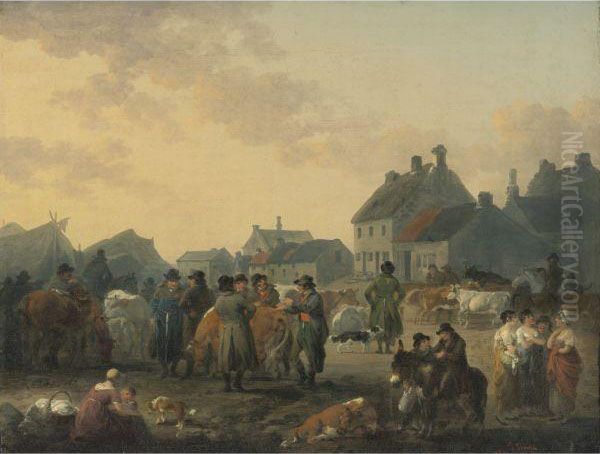
Although the mission ultimately proved unsuccessful due to Cathcart's untimely death en route, the journey itself was artistically fruitful for Ibbetson. The voyage took him via Madeira and the Cape of Good Hope, across the Indian Ocean to Java (part of modern-day Indonesia). During these stops and the time spent at sea, Ibbetson meticulously sketched and painted, documenting the exotic landscapes, local inhabitants, maritime activities, and atmospheric conditions he encountered. He produced numerous watercolours and drawings depicting Chinese subjects, offering valuable European perspectives on the region during that period.
Beyond this major voyage, Ibbetson undertook extensive travels closer to home. He explored the varied scenery of the British Isles, making sketching tours through Wales and visiting the Isle of Wight. These excursions yielded a wealth of material, allowing him to capture the specific character of different regions, from the rugged mountains and valleys of Wales to the coastal formations of the Isle of Wight. His travels in Ireland also contributed to his repertoire of landscape subjects. This commitment to direct observation during his travels infused his work with authenticity and a strong sense of place.
Artistic Style and Techniques
Julius Caesar Ibbetson's artistic signature is characterized by a blend of detailed observation, picturesque sensibility, and technical proficiency across different media. His primary focus was landscape, particularly the rustic scenery of Great Britain. He possessed a keen eye for the specifics of topography, flora, and the effects of light and atmosphere, rendering them with delicate, precise brushwork, especially evident in his oil paintings. His handling of foliage, water, and skies demonstrates a commitment to capturing the textures and moods of nature.
The influence of 17th-century Dutch masters, particularly the Italianate painters like Berchem, is undeniable. This is seen in his compositional structures, often featuring winding paths, carefully placed figures and animals (cattle, sheep, donkeys were favourites), and a warm, golden light bathing the scene. However, Ibbetson transcended mere imitation, adapting these conventions to depict the specific character of British landscapes and rural life, creating works that felt both timeless and grounded in his own era. His figures, often peasants, travellers, or washerwomen, are integrated naturally into their settings, adding narrative interest and scale.
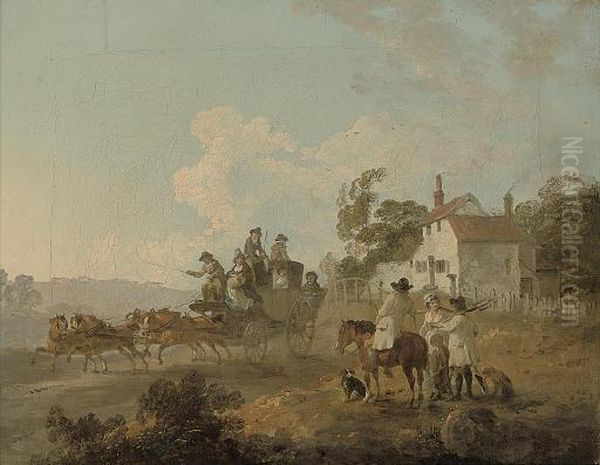
Beyond Dutch naturalism, Ibbetson's work also resonates with the burgeoning Romantic spirit of the age. There's often an emotional depth to his landscapes, a sense of nostalgia or contemplation. This is particularly apparent in works painted later in life, such as depictions of specific locations holding personal significance, like 'Willy's Hill', where topographical accuracy intertwines with personal memory and a longing for past happiness. His art wasn't merely descriptive; it often aimed to evoke a feeling or mood associated with the place.
Ibbetson demonstrated remarkable versatility. While renowned for his oil paintings, he was also a highly accomplished watercolourist, utilizing the medium's transparency and fluidity to capture subtle atmospheric effects. Furthermore, he engaged in printmaking and illustration. His technical expertise extended to writing; in 1803, he published 'An Accidence, or Gamut, of Painting in Oil', a practical guide for students, showcasing his understanding of artistic theory and practice. Some sources also mention a later publication, 'A Picturesque Guide', possibly from 1831, though this date falls after his death and might refer to a posthumous collection or a different work. His ability to work across these different forms highlights his innovative spirit and comprehensive artistic skill set. His unique handling of light and shadow, creating soft yet lively effects, particularly in coastal and water scenes, remains a hallmark of his style. He also occasionally turned his attention to social realities, depicting scenes of labour, such as in his views of quarries.
Key Works and Subjects
Ibbetson's prolific output includes numerous paintings that exemplify his style and thematic concerns. Among his representative works is 'The Falls at Tivoli', likely painted during a period spent exploring continental subjects, showcasing his ability to handle dramatic natural features and classical landscapes, a popular theme influenced by artists who made the Grand Tour. This work highlights his skill in rendering water and rock formations within a picturesque composition.
Closer to home, 'Market day, Masham' (1811) captures the bustling activity of rural English life. Masham, in Yorkshire, was where Ibbetson spent his final years, and this painting reflects his intimate knowledge of the local community and its rhythms. It demonstrates his talent for genre painting, integrating numerous figures and animals into a coherent and lively scene, characteristic of his later period.
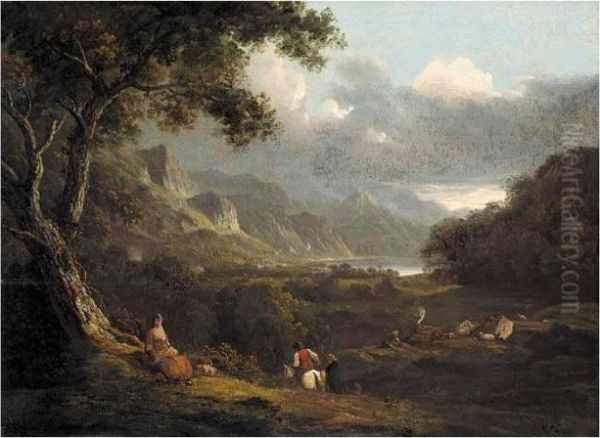
His travels in Wales inspired works like 'Washerwomen by the Deeps of the Dee, Llangollen'. This painting combines landscape with genre elements, depicting figures engaged in daily labour against the backdrop of the Welsh scenery he knew well. It showcases his ability to capture the interplay of light on water and the textures of the surrounding landscape, imbued with a sense of tranquil domesticity amidst nature.
'A View of Clapergates, near Ambleside' represents his engagement with the landscapes of the Lake District in England, a region gaining popularity among artists and tourists drawn to its sublime beauty. Although some source descriptions confusingly link similar titles to Welsh locations like Conwy Castle, the title clearly places this scene near Ambleside, showcasing his skill in depicting the specific topography and atmosphere of the Lakes.
His time on the Isle of Wight resulted in works such as 'Sand Quarry at Alum Bay'. This painting is notable not only for its depiction of the distinctive coastal geology but also for its inclusion of figures engaged in manual labour, offering a glimpse into the working lives of ordinary people within the landscape, adding a layer of social observation to the picturesque view.
Ibbetson also contributed significantly to John Boydell's ambitious Shakespeare Gallery project. He painted scenes from the plays, including two illustrations for 'The Taming of the Shrew' (Act 4, Scene 1 and Scene 5). These works required him to interpret dramatic narrative and character, demonstrating his versatility beyond pure landscape and genre subjects. These examples, alongside countless other depictions of rural England, Wales, and scenes from his travels, solidify his reputation as a master of the picturesque.
Connections and Collaborations
Throughout his career, Julius Caesar Ibbetson interacted with various figures within the British art world, relationships that shaped his path through patronage, collaboration, and mutual influence. His initial training under John Fletcher provided his foundational skills. A crucial relationship was with the influential publisher and print seller John Boydell. Boydell commissioned Ibbetson to create paintings for his famous Shakespeare Gallery, a major undertaking that involved many leading artists of the day, including George Romney, who Ibbetson likely encountered through this circle. Boydell's support extended beyond commissions, offering guidance and promoting Ibbetson's work.
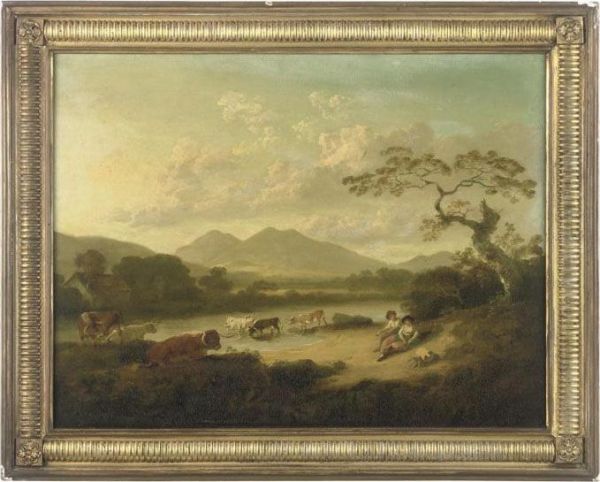
Ibbetson's travels, particularly in Wales, brought him into contact with other artists exploring the region's picturesque potential. He is known to have interacted with John William 'Warrior' Roberts, another landscape painter active in Wales whose style bore similarities to Ibbetson's. There appears to have been a degree of mutual influence, with Ibbetson perhaps encouraged by Roberts in his oil painting, while Roberts himself excelled in watercolour.
His exhibition record at the Royal Academy placed him within the orbit of the era's most prominent artists. While direct collaboration might not be documented with all, he worked during the time of figures like Benjamin West (President of the RA for much of this period), J.M.W. Turner, and John Constable, whose revolutionary approaches to landscape were developing concurrently. Ibbetson's more traditional, Dutch-influenced style offered a contrast yet shared the growing British fascination with landscape.
Other artists whose paths likely crossed with Ibbetson's, or whose work provided context or influence, include the watercolourists Thomas Girtin and Paul Sandby, pioneers in that medium. The earlier landscape painter Richard Wilson had already established a tradition of classical landscape in Britain. Furthermore, Philip James de Loutherbourg, known for his dramatic landscapes and innovative work in theatre design (eidophusikon), shared Ibbetson's interest in both landscape painting and theatrical effects. Ibbetson also knew and was influenced by artists like William Daniell, known for his topographical views. These connections situate Ibbetson within a dynamic network of artistic exchange and development in late Georgian Britain.
Personal Life and Challenges
Beyond his artistic achievements, Julius Caesar Ibbetson's life was marked by significant personal trials and tribulations. His unusual birth and the early loss of his mother set a precedent for a life that would encounter further hardship. His teenage years included not only the apprenticeship under Captain Helder but also a grounding in a Puritanical education, the influence of which is difficult to trace directly in his art but formed part of his early background.
Ibbetson experienced the joys and sorrows of family life. He married, but his first wife passed away, a loss that reportedly precipitated a period of severe emotional distress, described by some sources as a brief mental breakdown. This difficult period underscores the personal vulnerability beneath the professional artist. He found happiness again, marrying his second wife, Bella Thompson. Together they had children, including three who survived infancy.

However, tragedy struck again in 1794 when Bella died, leaving Ibbetson a widower once more, now responsible for the care of three young children. This loss, coupled with the demands of earning a living as an artist, must have presented immense challenges. These personal struggles, including periods of financial difficulty that sometimes plagued artists reliant on patronage and sales, add a layer of human complexity to his biography. Despite these adversities, Ibbetson continued to paint and travel, finding solace and purpose in his art.
Later Years and Legacy
In the later stages of his career, Julius Caesar Ibbetson continued to produce work, drawing on his extensive travels and deep familiarity with the British landscape. He eventually settled in Masham, a small market town in North Yorkshire, where he spent his final years. His connection to this area is evident in works like 'Market day, Masham', painted with the insight of a resident. He remained active as an artist and also consolidated his knowledge through writing, publishing his treatise on oil painting techniques in 1803.
His life concluded in Masham on October 13, 1817. He passed away at the age of 58 and was buried in the local churchyard, leaving behind a significant body of work and a reputation as one of the most accomplished landscape and genre painters of his generation.
Julius Caesar Ibbetson's legacy endures through his paintings, which are held in numerous public collections, including the Victoria and Albert Museum in London and Temple Newsam House near Leeds, as well as many private collections. His works are valued not only for their aesthetic qualities – the delicate brushwork, harmonious colours, and picturesque compositions – but also as historical documents. They offer vivid insights into the landscapes, rural life, and social conditions of Britain and the wider world during the late 18th and early 19th centuries.
He successfully bridged the gap between the influence of Dutch Old Masters and the developing traditions of British landscape painting, contributing significantly to the popularity of picturesque scenery. While perhaps overshadowed in popular memory by contemporaries like Turner and Constable who pushed landscape art in more radical directions, Ibbetson remains a crucial figure for understanding the artistic currents of his time, celebrated for his technical skill, his sensitive observation, and his enduring depictions of the natural world and human life within it.